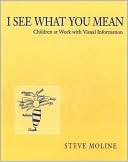

 |

|

Sold Out
Book Categories |
"Write your answer and if you have time left over, you can draw a picture."
This all-too-familiar instruction to children sends the unfortunate message that writing has content and value and will be graded, but drawing is optional and will be ignored.
Yet these assumptions are not true of real-world information texts, whether they are reference books or CD-ROM resources. Information can come in pictures as well as in words, and more usually in the kind of text that combines images with words. Teachers across the curriculum, therefore, have an obligation to teach students how to read and write these visual texts.
In this activity-laden resource book Steve Moline outlines learning/literacy strategies that require students to communicate graphically. Over 100 student examples illustrate how students can communicate some concepts better with visual texts than with conventional, word-only texts. These strategies will be especially helpful for students who struggle with writing or who are visual learners.
Noted writer and illustrator Steve Moline:
Login|Complaints|Blog|Games|Digital Media|Souls|Obituary|Contact Us|FAQ
CAN'T FIND WHAT YOU'RE LOOKING FOR? CLICK HERE!!! X
 You must be logged in to add to WishlistX
 This item is in your Wish ListX
 This item is in your CollectionI See What You Mean: Children at Work with Visual Information
X
 This Item is in Your InventoryI See What You Mean: Children at Work with Visual Information
X
 You must be logged in to review the productsX
 X
 X

Add I See What You Mean: Children at Work with Visual Information, , I See What You Mean: Children at Work with Visual Information to the inventory that you are selling on WonderClubX
 X

Add I See What You Mean: Children at Work with Visual Information, , I See What You Mean: Children at Work with Visual Information to your collection on WonderClub |